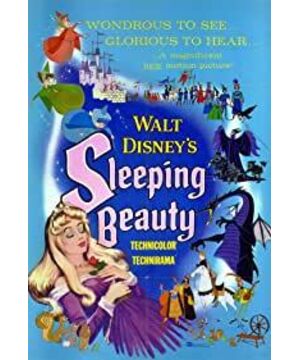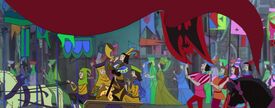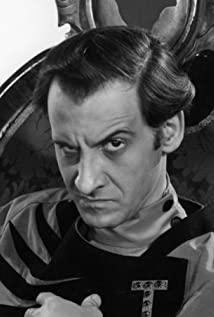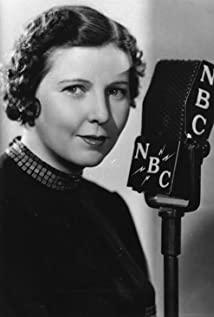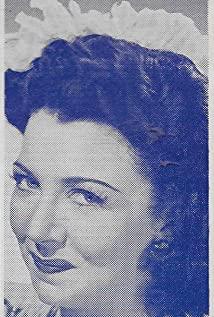Archaeology/Science-oriented film review, always in an unfinished state, super long article warning
Disney's launch of "Sleeping Beauty 2" on the 60th anniversary of the release of the "Sleeping Beauty" animated film must have been intentional. This article is mainly about the original story of "Sleeping Beauty in the Forest"-the animated film "Sleeping Beauty"-"Sleeping Beauty" The development process of "The Curse" series of live-action movies. And related behind-the-scenes stories.
In 1697, French writer Charles Perrault published a collection of folktales: "Stories in those old times" (Histoires ou Contes du Temps passé), which has a more famous subtitle: Tales of Mother Goose (Les Contes de ma Mère l'Oye) is "The Story of Mother Goose" (the name will be used to refer to the work in the following). This set of stories contains a story called "Sleeping Beauty in the Forest" (La Belle au boise dormant), this story tells the story of a king and queen who baptized their daughter, and an uninvited witch cursed their daughter. This story is full of wonderful elements: the cursed spinning wheel, A jungle of thorns and a hundred years of sleep have fascinated readers for centuries.
In this everlasting Sleeping Beauty story, many "storytellers" have been influenced at the same time, including writers, painters, poets, composers, choreographers and producers. For example, the Victorian British poet laureate Alfred, Lord Tennyson wrote a poem (Chapter 4 in The Day Dream. The Sleeping Beauty in Lovers) to describe a "a perfect form in perfect rest" girl. The ballet of the same name arranged by Pyotr Ilyich Tchaikovsky was first performed at the Mariinsky Theatre in St. Petersburg, Russia in 1890. Perhaps there is a most beloved interpretation of this story: Walt Disney's classic animated film "Sleeping Beauty" in 1959.
The animated film "Sleeping Beauty" was the pinnacle of Walt Disney Studios' aesthetic achievements at the time. It showed the growth and development of the animators who participated in the animated feature films "Snow White and the Seven Dwarfs" and "Cinderella". The breakthrough also showed a risky departure from the existing visual style of movies of the same type. Like Eyvind Earle’s embroidered tapestries in the Renaissance style, MarcDavis’s art nouveau princess, Milt Kahl’s fashionable but manly prince, and the energetic and comical fairies of Frank Thomas and Ollie Jhnston. Godmother, the impressively gorgeous villain of Davis. All this contributed to "Sleeping Beauty" which will continue to influence the creations of Disney, Pixar, and DreamWorks animators.
Based on various materials, this article introduces the history of the story of "Sleeping Beauty" in literature, music, dance, movies, and some details of the later "Sleeping Beauty"
Part 1: La Belle au boise dormant, the sleeping beauty in the forest
The combination of beautiful princesses, gorgeous princes, and "True Love Conquer All Evil" makes the story of "Sleeping Beauty" one of people's favorite fairy tales, "Prince and Sleeping Princess" the theme of fairy tales It has appeared in different cultures. The most well-known version is "Sleeping Beauty in the Forest" in Charles Perrault's "The Story of Mother Goose".
In the original story, the king and queen who longed to have a child gave birth to a daughter, so they invited all fairies in the kingdom to participate in the baptism of their daughters and presented them with various valuable treasures. In return, the fairies gave them This child has such virtues as beauty, charm, and musical talent.
But there was a fairy who was not invited. In Charles Perrault’s story, this was because the fairy was too old and lived in a very remote place. People thought she was dead. As a result, the fairy attended the baptism without being invited, and brought her "gift"-the princess would be stabbed to death by a needle on the spinning wheel. Fortunately, a young fairy was aware of the old fairy’s conspiracy in advance, and kept hiding at the ceremony until the old fairy gave a "gift" before showing up, came out from behind the tapestry, and used the curse of changing the old fairy as her Gift: The princess will not die, she will only sleep for a hundred years until a prince wakes her up.
Anxious to protect the princess, the king destroyed all the spinning wheels in the kingdom. Even so, one day, the princess found an old woman spinning thread with a spinning wheel in the attic of the castle. The princess had never seen anything like this before. Out of curiosity, she just Fingers were pierced by a spinning wheel and fell asleep.
The young fairy who changed the curse realized that if the princess woke up a hundred years later, she found the castle empty. So the fairy waved her magic wand, causing all the living creatures in the castle to fall asleep. At the same time, within a quarter of an hour, intertwined trees, shrubs, vines, and thorns spread around the castle, enclosing the castle impermeably, and only the high tower of the castle can be seen. Anyone who tries to pass through this magical jungle will eventually be trapped in it and die in pain. Only after the princess has slept for a full hundred years, the curse is lifted, the jungle will allow a prince to pass through.
In modern interpretation of the story, the prince usually wakes the princess with a kiss, but in Charles Perrault’s version, the prince just kneels by the princess’s bed and awakens the princess. When the prince helps the princess get up, the princess opens his eyes. He asked gently, "Is it really you? Prince, I have been waiting for you." In this story, Charles Perrault cleverly avoided the question that the prince would say, "The style of clothes she wears is as old as my grandmother's clothes". Finally the prince and princess got married naturally.
Charles Perrault’s story seems to be based on the "Sun, Moon and Thalia" in the story "Five Days" written by Giambattista Basile in the early seventeenth century. The latter It is borrowed from the legendary "Perceforest" (Perceforest) of the Arthurian period in the 14th century. The Grimm brothers were researching that the version of the story they discovered was influenced by the story of Brunhild sleeping in a magical flame in Scandinavian mythology (this is used in Wagner's "Ring of Nibelung". One element)
Folklorists have discovered that this kind of story of the prince awakening the princess and marrying it has existed from Ireland to India to Gabon. In some of these versions, the prince was originally married, but still married the awakened princess. There are several stories in which the prince conceives the sleeping princess, and the child sucks the princess’s finger to awaken the princess.
Charles Perrault and other authors added a terrifying second half to the story: the prince’s mother was a descendant of an ogre, and the prince’s father, the king, married the ogre simply because of desire Her wealth. After the king's death, the ogre queen ordered a butcher to kill the princess and her children and sacrifice them to the queen. However, the butcher deceived the queen and did not kill them. Instead, he roasted the baby goat with a delicious sauce and offered it to the queen. The queen claimed with satisfaction that it was the most delicious thing she had ever eaten.
When the queen realized that she had been fooled, she was about to throw the butcher and his family into a pit full of snakes, toads and other poisonous insects. But the prince arrived in time at the critical moment and saved the butcher's family. At this time, the queen was dazzled by resentment and frustration, and fell into the pit. The prince felt sad because "it was his mother after all", but soon, he comforted his conscience with the rescue of his wife and children.
Many fairy tales have a dark ending: in "Snow White", the evil queen finally puts on red iron shoes and dances to death. At Cinderella's wedding, the black bird pecked the eyes of Cinderella's sisters. In some versions of "Beauty and the Beast", Belle's sisters become statues and are forced to witness Belle's happy life until they repent.
In the Brazilian version, the prince’s first wife wanted to feed the prince’s children to the prince in order to avenge the prince’s preference for Sleeping Beauty. But Charpero slyly turned the story to another story, grafting it bluntly at the end of the first story. In "The Uses of Enchantment: The Meaning and Importance of Fariy Tales", psychologist Bruno Bettelheim noticed, "Charpero’s story has been reduced to two parts where two bulls’ heads are wrong: the first part is The prince awakens Sleeping Beauty and marries her; the next part is that the mother of "Prince Charming" is actually an ogre who eats children..."
Charperot's story was first translated into English in Robert Samberd1's "Histories, or Tales of Past Times," in 1729, and was subsequently translated into various language versions.
Countless writers and artists have re-created the first half of Charpero's story, and there are many outstanding figures in the nineteenth century. The editor and publisher CS Evan prepared a story that matched the content of the illustration for the famous artist Arthur Rackham's illustration in 1900. Designer, artist, and author WillIan Morris wrote several poems to correspond to his friend, the Briar Rose series of poems by former Raphaelite painter Edward Brune-Jones from 1890 to 1895.
The Legend of Briar Rose group painting and William Morris's accompanying text one:
"The fateful slumber floats and flows About the tangle of the rose; But lo! the fated hand and heart To rend the slumberous curse apart!" —— William Morris
The Legend of Briar Rose group painting and William Morris's accompanying text two:
Here lies the hoarded love, the key To all the treasure that shall be; Come fated hand the gift to take And smite this sleeping world awake." —— William Morris
Victorian poet laureate Alfred and Lord Tennyson wrote two poems about the sleeping princess.
Contrary to these romantic versions, Nobel Prize winner Anatole France launched the satirical "The Story of the Duchess of Cicogne and of Monsieur de Boulingrin" in 1920. In this bitter and mean story, the evil fairy was not invited to the baptism banquet because she was not noble enough by her birth.
Many critics in recent years have complained about the passiveness of the characters, especially the heroine. Just like Snow White who bit a poisoned apple, Sleeping Beauty can't do anything strictly until the prince comes to rescue her. Other commentators found that the prince himself was only a little more proactive. The reason why he was able to travel through the jungle where the spell was cast was not because of his strength and bravery, but simply because he chose the right time. Those knights who tried to enter before the spell was cast for a hundred years were all swallowed by the forest. I have to say that the prince is very lucky.
Bruno Bettelheim argued that the negativity of the characters in the original work is what makes this story particularly valuable in the highly developed twentieth century: "It is the'Sleeping Beauty' that is old enough, so this story can give today's young people a lesson. The more important message. That is the fear of young people and their parents about the quietly coming growth, because people tend to set goals for the visible. "Sleeping Beauty" tells one such truth: a long time of stillness, Contemplation, focusing on oneself often leads to achievement"
From the perspective of female puberty growth, we can regard the princess’s deep sleep as a “necessary stage of growth”. Just after a hundred years, the prince married the Sleeping Beauty without experiencing many challenges, which is surprising. However, the central theme of this story is a hundred years of sleep and "expiry". This one hundred years is a metaphor, it is the time for the princess to wait in the depths of her heart and grow up in wisdom. It is not difficult to see that it is a kind of "waiting" for the person who meets for the first time to say "Is it really you?" "Expiry".
However, Charpero wrote the conclusion of the story in his notes: Women must learn to wait for the arrival of a rich, handsome, brave, and gentle husband, but I am afraid not many young women know that this husband is going to sleep on their own. It will take a hundred years to arrive at this thing and then you can fall asleep peacefully.
Part Two: St. Petersburg in 1890
During the 18th and 19th centuries, artists tended to bring fairy tales to the stage. For example, in 1757, Jeanne-Marie Leprince de Beaumont published the most famous "Beauty and the Beast" story in France. 14 years later, French composer André Grétry's opera "Zémire et Azor" based on this story (Opéra comique) was a huge success.
Similarly, the magic of "Sleeping Beauty" has attracted many composers. Italian composer Michele Carafa (1825), British playwright James Planche (1840), German composer Engelbert Humperdinck (1902), French composer Maurice Ravel (1910) each created an appointment or a play involving this subject.
Of course, this story is the best known, and the most beloved way of musical interpretation is of course ballet-by Pyotr Tchaikovsky (Peter Ilyich Tchaikovsky), Marius Petipa (Maurice Petipa), Ivan Vsevolozhsky ( Ivan Vsevoloysky) A masterpiece created by these three geniuses. This project started with Ivan Vsevoloysky, the director of the Royal Theatre of St. Petersburg, Russia. He approached Tchaikovsky to discuss the creation of a ballet based on Perot’s fairy tales, including some other fairy tale characters. Compose by Tchaikovsky and choreographed by Petiba. Tchaikovsky did not hesitate to accept the commission, even though his first ballet "Swan Lake" was not successful when it premiered. Tchaikovsky’s script was based on the translation of the Brothers Grimm. The German translation of Perot’s "Sleeping Beauty in the Forest", that is, the final ending is that the entire court wakes up after 100 years of sleep to celebrate the Sleeping Beauty Princess. wedding. At the same time, Vsevoloysky also wrote the characters that Perot created and appeared in other stories, such as the cat in boots and the little red riding hood, and so on. And Tchaikovsky also expressed to Vsevoloysky that his creative process was very pleasant and he had enough inspiration to complete the work.
The three artists finally created a four-hour "fairy ballet", including a finale that was as grand and prosperous as the court of Louis XIV. But this work lacks a continuity of narrative that Russian audiences at the time expected.
"Sleeping Beauty" premiered at the Mariinsky Theatre in St. Petersburg on January 3, 1890. The audience's feedback was very bad for the first time: the comment condemned the music for being too "symphonic" and not suitable for dance. The audience complained about the French style, the theme of fairy tales and " The lack of choreography. Some critics claim that Charperot’s story is not suitable for ballet adaptation at all. Obviously, the first audiences of "Sleeping Beauty" reacted indifferently, even though the St. Petersburg newspapers reported both the bad reviews of "Sleeping Beauty" and the lace news that the female protagonist of "Sleeping Beauty" received flowers and jewelry from admirers.
Even if the first reaction was not satisfactory, "Sleeping Beauty" quickly found an audience who would appreciate it. "Sleeping Beauty" has been relaunched many times, usually in cut-down versions subject to budget. Sergei Diaghilev created a gorgeous adaptation: The Sleeping Princess. It was performed by Ballets Russes in London in 1921. Although it was of great artistic value, this ballet received a mediocre response and made ends meet, which brought Sergei Diaghilev an economy. disaster. Three years later, Nicolai Vinogradov of Monumental Theater tried to create a "Marxist" version of the "Sleeping Beauty" ballet. One of the scenes is described as follows:" In the red light and red flag, Princess Aurora, the fate of the world At dawn, I woke up. "Fortunately, this play was never staged.
Marius Petipa's choreographic design was constantly changed and replaced in subsequent editions, however, most of it was retained in the remake of the Mariinsky Theatre on April 30, 1999.
The delicate and elegant melody of "Sleeping Beauty" has earned Tchaikovsky a place in various symphony performances. The story of "Sleeping Beauty" is also well-known to music lovers, including Walt Disney. Disney said, "From the early At the beginning of the animation, music is always in an extremely prominent position in our works. I can't imagine what the picture of the story would be without the matching of music. The theme of music always appears first, suggesting a way to deal with the story. Chai Ke That’s how Wowski’s music in "Sleeping Beauty" is, and this influence ultimately shaped the way we use expression in classic animation."
Part Three: White Jade Slightly Flaws-Disney's "Sleeping Beauty"
"What we want out of this is a moving illustration.
I don't care how long it takes"-Walt Disney told the crew
Following the "Miss and the Tramp", Disney will launch another widescreen work-"Sleeping Beauty". The film was high hopes at first, but the work almost became a disaster in the end. Fortunately, Arlo later belonged to the "Disney Princess" brand and did not suffer a forgotten fate.
As the third fairy tale feature films based on fairy tales after "Snow White" and "Cinderella" (The Adventures of Pinocchio (1883) is a novel, not a fairy tale) "Sleeping Beauty" Among the three films, it is the most delicate and meticulous one. "Snow White" shows the artist's pioneering exploration of the charm of a new carrier (color feature film), and "Cinderella" shows 13 years later. The maturity and stability of the artists. What makes the first two incomparable is the pure visual richness in "Sleeping Beauty."
Disney artists encountered many challenges when adapting the plot, characters, and the plot of the original story. The story team found that this story needs to be constantly revised to fit an animated film. "After the princess wakes up, she married a man who broke into her bedroom" is too strange, so the story team joins the "Boy-meet-girl" plot common in youth romantic comedies in the 1950s. Moreover, a prince far younger than the princess seems to destroy the romance of the story, even if the princess does not age in sleep. So the story team reduced the heroine's sleep from a hundred years to one night. However, the absence of the princess during the climax of the story cannot be avoided. For many viewers, the absence of the heroine after half of the story is the biggest disappointment in the movie.
It took a lot of manpower and material resources to shape the image of the seven dwarfs in "Snow White". So Disney artists reduced the twelve good fairies in the original book to three. The artists also portrayed the role of Marlene Fissen, who is completely different from the "shrinking old woman" in the original book. The image of Marlene Fissen is close to the evil warlock in fantasy literature. She is beautiful, ruthless, cruel, conceited, powerful, and has one of the most threatening traits as a villain-superior intelligence. The inspiration for Marc Davis when designing this character originally came from a Renaissance painting in which a woman wears a headpiece that looks like a horn. In the process of continuous improvement of the design by Marc Davis, he added a robe with toothed edges to the character, which looked like it was surrounded by flames. The most important thing about this character is that she will not have too many movements. Marc Davis understands this: "Marlene Fissen is a problem. She is basically a speaker: she just stood there and talked directly to other characters. Such an image is very difficult, we make her look like a A bat in a robe to strengthen the sense of drama." Even with limited playing time, Marlene Fissen has undoubtedly become the dominant role in "Sleeping Beauty."
Walt Disney chose Eyvind Earle to design the background for the film and at the same time gave him creative freedom to achieve the "moving illustration" effect that Walt Disney expected. Eyvind Earle's wide shadow style can be traced back to medieval tapestries and early Renaissance paintings, as well as a touch of Persian miniature and Japanese prints. He created a flat and detailed world completely different from "Snow White" and "Cinderella".
The characters in the film are also specially combined for these backgrounds. Tom Oreb has undertaken a lot of character design work, and Marc Davis and Milt Kahl have undertaken the animation parts of Arlo and Prince Philip respectively. In order to integrate the characters into the world created by Eyvind Earle, Tom Oreb made these characters look more upright than traditional Disney characters. At the same time emphasize a contrast between straight lines and curves. His line drafts reflect a slender and slender feeling, which is different from the early images of young girls like Audrey Hepburn. The edges and corners of the character's outline are "softened" by the curly hair and shawl. Marc Davis intensifies this line contrast in the animation.
The roles of Marc Davis and Milt Kahl are the most difficult, so that whenever an artist complains that his work in "Sleeping Beauty" is too difficult, Walt Disney will pause and respond: "Well, in this case, you You can draw the prince’s animation!” In the past, the animations of realistic characters always fell on the shoulders of Marc Davis and Milt Kahl. They joked that because of their excellent painting skills, they finally "reduced" to only these realistic paintings. Hero and heroine. At the same time, I envy those animators who draw "clown" and "follower" characters-because these characters can bring laughter to the audience. Davis explained: “The protagonist takes on your entire story. If the protagonist can’t convince you, the comic character is meaningless. It’s very interesting to create a comedy character, and it’s very interesting to see the audience laugh because of this character in the theater. An unparalleled sense of accomplishment. But if the audience reacts coldly to the prince and princess, all their efforts will be in vain."
Unfortunately, the biggest problem with "Sleeping Beauty" is the lack of input from Walt Disney. When "Sleeping Beauty" was officially put into production, Walt Disney was busy shooting live-action movies such as "Seal Island" and "The Living Desert." Objectively speaking, the success of "20000 League Under the Sea" and "Davy Crockett" gave Disney a place among real-life filmmakers. At the same time, Disney began to try to develop a new medium: TV channels. At that time, many film studios regarded TV shows as a threat to the film industry. Disney uses TV commercials to raise funds for his important idea, Disneyland. ABC TV is one of the first investors in Disneyland. In the fall of 1954, the construction of Disneyland officially began in Anaheim, California: two months later, the news of "Disneyland" was broadcast on ABC, which was a very useful way of publicity. Disneyland officially opened in July 1955. On October 3 of the same year, "Mickey Mouse Club" was broadcast on ABC. (The young actor who participated in the recording of this show has a title: Mouseketeer, one of whom is the voice of the young prince in "Sleeping Beauty")
Success in the above-mentioned areas has transformed Disney's studio into a larger and more diverse company. At the end of the 1940s. Walt Disney complained that the studio always focused on "the success of the next animated feature film." Expansion of the company's business scope is indeed conducive to enhancing the company's stability, but this reduces the company's most important thing-the importance of animation production.
During the production of "Sleeping Beauty," Walt Disney was always worried about other things. As a result, he often ignored the production of "Sleeping Beauty" for several weeks. As a result, the genius and creativity that Disney used to create the original story was absent in "Sleeping Beauty". In this way, "Sleeping Beauty" was costly. It took 6 years to complete the production. In January 1959, "Sleeping Beauty" was released in theaters, but it seemed to disappoint the audience. Most of the media's evaluation of "Sleeping Beauty" was not high. Although the role of Marlene Fissen is very exciting, it also reflects the fact that the hero and the heroine of the film are only equivalent to two symbols , and they easily disappear from the background of the film. (This also paved the way for "Maleficent" to focus on Maleficent, ignoring the princess and prince. Disney's lack of input made this movie unable to achieve the same look and feel as "Snow White" and "Cinderella". At the box office, after removing various costs, "Sleeping Beauty" eventually brought Disney a million dollars in loss. "Sleeping Beauty", like "Fantasia", did not achieve commercial success at the time. Fortunately, the video tapes and DVDs of the later "Sleeping Beauty" were widely acclaimed. In 1990, Arlo, as a member of the "Disney Princess" brand, proved very successful in its peripheral products.
Like "Fantasia", "Sleeping Beauty" is considered a flawed animation masterpiece. Its plot is not as exciting as "Pinocchio", and its characters are not as innocent and emotional as "Snow White". The resonance is not as good as "Dumbo" and "Bambi". However, it is still a victory for animation art. Disney's animation studio is like a Renaissance workshop. The emphasis on learning, research, experimentation, and continuous modification and improvement is the key to Disney's victory.
In an interview with the re-release of "Sleeping Beauty" in 1979, the sequence director of "Sleeping Beauty", Eric Larson, was interviewed: "What would happen if a budget equivalent to three times that of the time was given to remake this movie? "(In a sentence) Eric Larson paused and replied: "But even if you have the money, where can you find people who are like the geniuses at the time? The crew at the time were all top-notch. , And their animation is close to the perfect state you want. Since 1934, we have created a world of work, research, and pursuit of perfection with Walt Disney’s brushes. Today’s animators just don’t have this Experience. There has never been such a time before, and there will never be again."
Part 4: Subversion or inheritance? —— "Sleeping Mantra" series remake (to be continued
View more about Sleeping Beauty reviews


